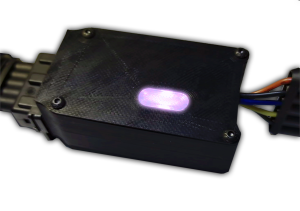SSSICK/User Manual/R019: Difference between revisions
No edit summary |
|||
| Line 1: | Line 1: | ||
=Using the SSSMCK= | |||
For most users, it will be as simple and plugging in the input sensor and SSSMCK then driving away. For other users, you may wish to tune the unit for a new sensor, vehicle, or even for performance. You can read about the operation and control of the SSSMCK on this page! | |||
=LED Display= | |||
The SSSMCK has an LED that displays operation and errors, internal error checking that can output specific codes to Buoy for diagnostics, dynamic short-term and long-term corrections, and the ability to tune various parameters. | The SSSMCK has an LED that displays operation and errors, internal error checking that can output specific codes to Buoy for diagnostics, dynamic short-term and long-term corrections, and the ability to tune various parameters. | ||
In all versions UNTIL R019, the LED normally operates in fader mode, where it's color is directly related to MAF flow rate. It will be green at low flow and fade to blue at higher flow rates. It will illuminate red if an error is detected. | In all versions UNTIL R019, the LED normally operates in fader mode, where it's color is directly related to MAF flow rate. It will be green at low flow and fade to blue at higher flow rates. It will illuminate red if an error is detected. | ||
Revision as of 07:07, 10 July 2022
Using the SSSMCK
For most users, it will be as simple and plugging in the input sensor and SSSMCK then driving away. For other users, you may wish to tune the unit for a new sensor, vehicle, or even for performance. You can read about the operation and control of the SSSMCK on this page!
LED Display
The SSSMCK has an LED that displays operation and errors, internal error checking that can output specific codes to Buoy for diagnostics, dynamic short-term and long-term corrections, and the ability to tune various parameters.
In all versions UNTIL R019, the LED normally operates in fader mode, where it's color is directly related to MAF flow rate. It will be green at low flow and fade to blue at higher flow rates. It will illuminate red if an error is detected.
Starting with hardware R019 the LED now only displays the current operating mode of the unit, or illuminates red upon detecting any errors.
The R019 LED looks like this:
Gauges and add-ons
We offered a few options on earlier versions, from R006-R0012, but have discontinued gauges from the time-being. If you need assistance with a gauge, please contact us directly.
Error Codes
The SSSMCK is capable of displaying a number of error codes that can tell you exactly what, if any, issue it is experiencing. All systems have self-checks coded-in, and if anything is out of specification or an item fails, the SSSMCK will know immediately. An LED that is illuminated red is an easy way to tell if there are any issues.
These error codes are stored in non-volatile memory, meaning that they will be stored even between power cycles and storage.
From the connection menu of Buoy, you will see an option to "Read Error Codes". Click this to check for any stored error codes.
There are two ways to clear codes. The first and recommended way is to correct the error (bad sensor, low voltage, etc), and let the unit run until it recognizes correct operational parameters for enough time (about 5 minutes). The second is to click on the "Clear Error Codes" button from the connection menu of Buoy.
Some error codes cannot be cleared by running the unit under normal circumstances, such as read/write errors (these appear if the unit receives bad information or was unable to properly store the programmed tune). If this happens, you can click "Clear Error Codes" and try uploading the tune again. If this continues to happen, there may be a damaged component within the SSSMCK. Please contact us and we will get you setup with a repair or replacement at NO CHARGE!
Tuning
Tuning from within Buoy is currently in alpha-stages, it will be available publicly soon!
Parameters
Input Sensor
There are many different input sensors to choose from: Mass AirFlow sensors, Throttle Position sensors, and Manifold Air Pressure sensors. While each unit is shipped pre-programmed for the sensor you chose at checkout, you can always reprogram it for a new sensor later.
You can use one of the available MAF sensors freely without the need for a specific ECU tune. However some sensors, such as TPS and MAP, require you to have a specific ECU tune in order to run properly.
Output VAM
This is the sensor that your ECU is tuned for. This is almost certainly the stock VAM that your vehicle was equipped with, unless it was changed and your ECU was retuned for another sensor at some point.
Averaging
Enable to allow the SSSMCK to perform software averaging of signal processing. This is enabled by default.
We recommend a setting of somewhere between 20 and 40. A larger value means slower reaction, but perhaps smoother operation. A smaller value means sharper response, but an overly small value will provide the ECU with too much noise and may cause rocky operation.
- Recommended values based on input sensor used:
- MAF: 20-40
- TPS: 5-15
- MAP: 25-50
Manual Correction
Enable this to allow the making of manual corrections to output. This scalar is part of a final output equation. Adjusting this directly affects the calculated airflow. (E.G. 100 kg/hr will be converted to 105 kg/hr with a correction scalar of 1.05)
Dynamic Correction
Leave this disabled unless you are having issues with fuel ratios that cannot be fixed with minor manual corrections.
Enable this to allow the SSSMCK to automatically make corrections to output based on discrepancies. This scalar cannot be set manually as it is dynamic and the SSSMCK will automatically learn different values for different airflow ranges.
This scalar directly affects output signal directly and not airflow values. This is used to adjust for voltage inputs that are slightly out of spec.
- Correction Limits
- The MINIMUM and MAXIMUM scalar values for how far the SSSMCK can go to make automatic adjustments.
- We recommend setting these limits to no less than 0.90 and no more than 1.10.
Custom LED Color
With our newer firmwares the LED operation has changed. You can now set your own custom LED color for normal operation. The default normal operation LED color is green. Resetting the unit to default values will also reset your custom LED color to green.
This is expressed as an 8-bit integer value (between 0 and 255). A higher integer means a higher saturation of that color. Setting red, green, and blue to 255 will produce a white light. Setting all to 0 will produce no light. Setting red to 255, green to 0, and blue to 255 will produce a purple light.
Timer Periods
Adjust these to change how often the SSSMCK will perform certain activies and checks.
Timer Period 1
Timer Period 1 handles functions such as dynamic correction updates and manual correction updates. Lowering this will increase how often these corrections are made and updated. Raising this will slow down corrections.
Recommended values are between 40 and 60.
Timer Period 2
Timer Period 2 handles functions such as error checking. Lowering this will increase how often error checks are made. Raising this will slow down error checking. Recommended values are between 80 and 180.
M40/2 Mode
The M40/2 VAM has three outputs, one for IAT and two for airflow. Therefore an additional wire is added to units destined for an M40 or M42 engine. M42 mode enables the output of all three of these signals to the ECU.
- Operation Mode
- Default: The standard operation mode, what most people will use.
- Sweep: Used if the "default" option is providing inconsistent results.
- Inverse: We've found that the E36 M42 models prefer this setting.
- Threshold kg/hr
- The airflow rate at which M42 mode is active, Typically this is set to around 10-30.
- Output rate
- A scalar for the additional output signal. This is used to adjust for any possible discrepancies.
Reset to default values
If you ever have trouble, you can easily reset everything to default values from within Buoy. Instructions will be available with the release of the next version of Buoy.








